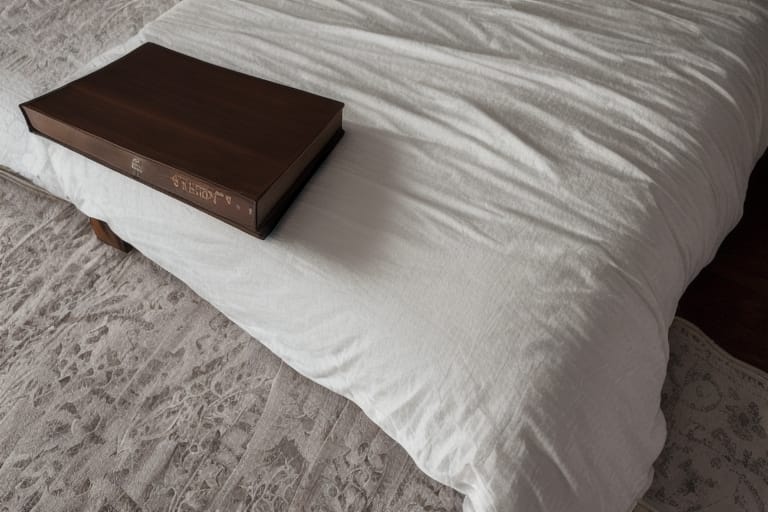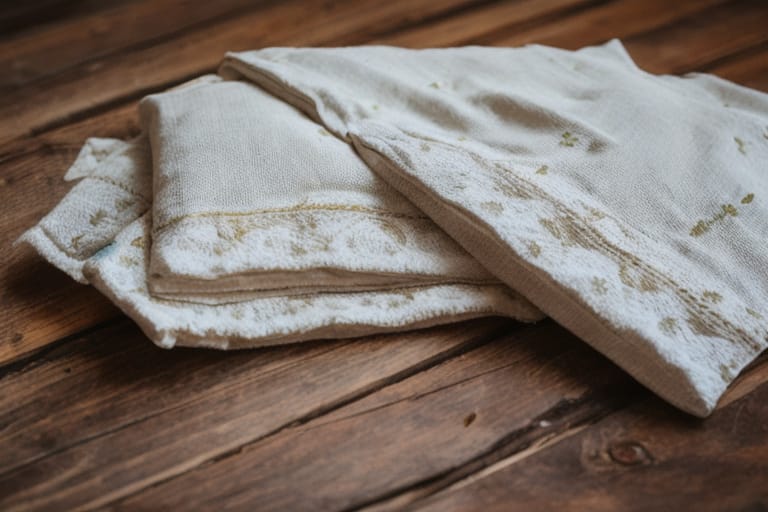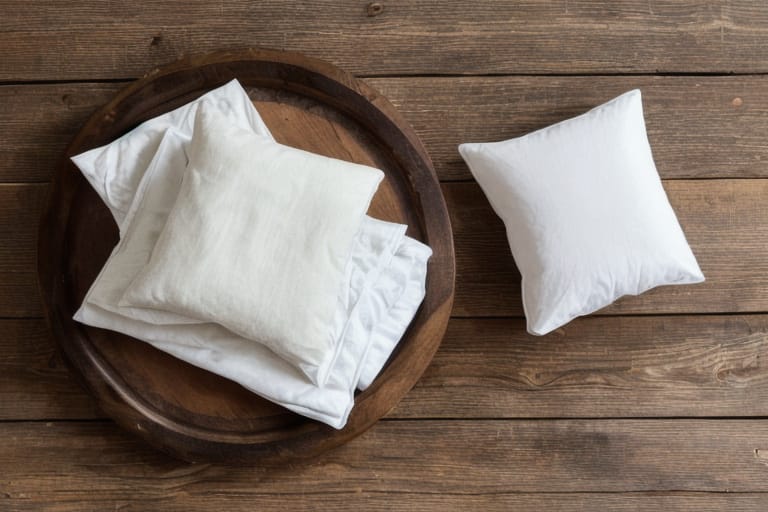Down comforters evoke images of snuggling under a fluffy, welcoming white blanket on a cold winter night. But have you ever wondered why down comforters are always white instead of available in a rainbow of colors?
There are practical reasons why the vast majority of down comforters on the market today are white or off-white. Down filling, sourced from ducks and geese, naturally comes in white and off-white shades. Choosing white outer shell fabrics allows the down interior fill to show through for that light, billowy look that’s a hallmark of quality comforters.
Read on to learn why white reigns supreme when it comes to down comforters, from the source of the super-insulating fill to manufacturing considerations and care recommendations to keep your bedding bright and lightweight for years to come.
Sourcing the Best Down Fill: The Whitest of the White
The fill power of down refers to both its insulating abilities and fluffiness. Fill power ranges from about 300 to 900; higher numbers indicate better quality in terms of providing warmth without weight. Most down used in mid-to-high end comforters has fill power ratings between 600 and 800.
Down is the undercoating of geese and ducks that provides insulation and protection in cold water climates. European white goose down is widely considered the highest quality fill available, known for both exceptional loft and durability over years of consistent use.
Goose down, in particular the large European strains bred specifically for bedding production, produces more fill per ounce harvested compared to standard duck down. All natural white goose down has a bright white appearance when cleaned properly, versus more yellowish shades found in lower grades of down or feathers.
Takeaways: Why White Goose Down Rules
- Insulation: Goose down provides unmatched warmth for its lightweight feel
- Loft: Goose down boasts the best fill power for billowy comforters
- Durability: High quality goose down maintains loft and insulation over time
- Supply: European white goose down production meets demand
- Appearance: Bright white color signifies top grade down
Pairing lofty white goose down interiors with crisp white outer layers allows manufacturers to produce that light, cloud-like profile synonymous with luxurious down bedding.
How Fill Power Impacts Function and Fluff
Higher fill power numbers indicate finer, more insulating down cluster pieces. Fill power is tested by measuring the cubic inches one ounce of compressed down fills when released into a chamber.
Down graded at 800 fill power puffs up almost twice as much as 500 fill power batches. That superior expansion translates into better coverage inside the comforter, allowing less down to provide increased warmth.
High fill power down also tends to recover well after compression during shipping or storage, quickly regaining loft for long-lasting comfort and warmth over years of use.
Advantages of High Fill Power
- Lightweight feel
- Superior loft and billowy thickness
- Enhanced durability over time
- Excellent insulating properties for warmth
- Resilient recovery after compression
High fill power down clustered inside baffled compartments layered within breathable outer fabrics delivers everything you want in a premium down comforter.
Special Construction: Reinforced Baffles Ensure Loft
Beyond fill power, several structural components factor into down comforter quality. Sturdy construction starts with reinforced inner baffle boxes that encase down in smaller compartments. These pockets allow the fill to fully expand and trap body heat.
Without interior fabric walls, down would shift unevenly. Dense spots would develop thin over time, compromising insulation. Reinforced baffle boxes maintain an even distribution for consistent comfort and warmth.
Box-stitching offers an alternate design replacing baffles with sewn threads securing fill in tidy squares. This method involves more total stitching that can potentially allow tiny feathers to poke through over years of repeated fluffing.
For most sleepers, baffle box construction provides the best experience:
Advantages of Baffle Boxes
- Maintains loft over years of use
- Prevents shifting for even insulation
- Limits feathers from poking through fabric
- Creates a flatter, tidier surface appearance
Whether secured in baffles or stitched boxes, the entire down-filled insert then fits inside the comforter’s outer shell. This protective barrier shields the delicate interior from damage while allowing air flow.
Luxury down Comforters Demand High Thread Counts
The outer shell plays a vital role in comforter quality. Premium down bedding typically comes wrapped in a tightly woven 100% cotton sateen fabric renowned for both softness and strength.
With thread counts ranging from 300 to over 600, the highest echelon of cotton sateen bedding feels almost silky against skin. The tightly packed threads create a breathable weave protecting filling while allowing air to freely circulate. Cotton also makes a crisp backdrop to showcase fluffy white down.
More affordable down comforters may use polyester or cotton-synthetic blends. But for the luxury tier:
Why Cotton Sateen Excels
- Smooth and strong weave
- Allows airflow to loft down
- Provides soft, comfy feel
- Luxurious appearance
- Durable over years of use
Along with reinforced inner baffles and a woven cotton shell, manufacturers pay special attention to seam construction for optimal durability. Reinforced piping around the edges helps prevent tears so you can enjoy your investment for the long haul.

Responsible Sourcing: Animal Welfare and Safety Certifications
Another reason white down rules comes down to ethics. As consumer awareness expanded around the potential abuses animals may endure in industrialized supply chains, bedding brands have implemented standards ensuring humane practices from farm to shelf.
Both the Responsible Down Standard (RDS) and OEKO-TEX Standard 100 certify textile supply chains promote animal welfare and product safety:
Reputable brands only use certified responsible down traceable back to ethically operated sources. Farms must pass regular audits under a strict code including:
- No force-feeding or live plucking
- Adequate space, light, shelter
- Humane handling procedures
OEKO-TEX sets limits on over 100 substances tested for materials safety. Certification guarantees comforters contain no harsh chemicals or potential irritants.
Between animal welfare and product testing requirements, certification programs endorse needles sourcing white down produced in line with fair, sustainable methods demanded by educated consumers.
Shopping with Standards: What to Look For
Between fill power, construction approaches, outer fabrics and ethical sourcing, what should you look for when evaluating options to find the best down comforter?
Check certifications confirming responsible, humane material production. Carefully inspect stated fill power and fabric selections. Read customer reviews praising durability and loft over years of use.
Within your budget, prioritize the highest fill power available from quality brands specializing in down bedding back by meaningful warranties. Expect to invest $200 to $500+ for a queen size comforter meeting these ideals of luxury construction.
Proper Care Keeps Down Comforters Fluffing Along
Once you bring home your splendid new white down comforter, proper maintenance preserves both appearance and performance season after season. Follow these best practices:
- Dry clean for best results to prevent moisture damage
- Machine wash 2-3 times annually on delicate cycle
- Avoid chlorine bleach to protect fabrics
- Low heat tumble dry with tennis balls adding loft
- Store flat or loosely folded in breathable space
Give your down comforter the occasional fluff by gently shaking or using the air from a blow dryer to revive flattened spots.
Follow clothing care symbols for ideal cleaning methods. With proper maintenance, a quality white down comforter should deliver divine comfort for a decade or longer.
Different Warmth Levels Suit Individual Comfort Needs
While many down comforters look innocently similar in their puffy white exteriors, they conceal inner differences when it comes to warmth. Just as winter coats offer lighter or more extreme insulation against the elements, down comforters range from breathable lightweight versions for summer to ultra toast exuding warmth perfect for frigid nights.
These distinct comforter levels each serve a purpose depending on your sleeping preferences:
Summer level choices work well in warmer areas or for people prone to sleeping hot. Higher fill power down provides breathability and just enough insulation during cooler months without causing overheating.
Lightweight styles balance moderate warmth for wide seasonal appeal. They trap body heat during chilly weather yet remain comfortable into spring and fall in many climates.
Ultrawarm comforters brim with high fill power down nestled between thick baffle boxes with tightly woven outer shells. Made for freezing climates, these cozy layers emanate heat all night long when bitter cold sets in.
Having options means finding your personal sweet spot – whether you prefer a delicate breathable comforter or indulgent thick, enveloping warmth capped in white.
Cuddledown: Setting the White Down Standard
Among luxury down bedding brands, Cuddledown stands apart through their adamant commitment to quality, safety, ethics and service. This family-owned New England company has specialized in goose down comforters since 1972.
The Cuddledown difference starts with responsible procurement. They only use certified humane European white goose down and woven cotton sateen shells, both sourced from long-term partners. Their down meets the IDFL laboratory’s standards verifying 750+ fill power through independent analysis.
From start to finish, Cuddledown maintains exceptional control over production by manufacturing at their Fall River, Massachusetts headquarters. Skilled workers cutting fabric and meticulously constructing comforters onsite enables extremely stringent quality control throughout every step.
These comforters receive RDS certification confirming humane treatment alongside OEKO-TEX class 1 accreditation verifying safe, sustainably produced materials. Coupled with highly personalized customer service and their lifetime guarantee, Cuddledown sets the pinnacle standard for luxury white down bedding.
Common Down Comforter Dimensions
As you shop different brands’ offerings, sizing terminology largely remains consistent. From twin beds to oversized western kings, you’ll find a variety of dimensions to suit any modern bed frame:
Twin: 66” wide x 86” long Full/Double: 86” wide x 86” long
Queen: 90” wide x 90” long King: 106” wide x 90” long California King: 106” wide x 102” long
While twin and full sizes work well for children and guest rooms, queen mattresses remain today’s most popular couple’s bed. Investing a quality down comforter made to endure here ensures restful sleep for years ahead.
Timeless White Down Comforters: Snuggle-Worthy Luxury
Whether you seek reliable warmth during a nasty winter or breathable comfort through muggy summer nights, white down comforters deliver on all fronts. Snuggle under this cherished bedding classic knowing the story behind what makes well-crafted models the pinnacle of insulation, softness and refined beauty destined to be passed between generations if properly cared for.
The sought-after qualities making European white goose down so exceptional explain why most high-end comforters feature this hypnotizing fill enclosed in resilient white baffled channels. When shopping, look for lofty fill power numbers from reputable suppliers paired with smoothly substantial cotton sateen shells for the ultimate luxury.

Frequency Asked Questions
Why are most down comforters white or off-white?
Down comforters are white because the highest quality goose and duck down used as fill inside comforters is naturally white or off-white. Choosing white outer shell fabrics allows the bright white down interior to show through for that signature billowy, cloud-like aesthetic that’s become synonymous with luxurious down bedding.
What should I look for when buying a down comforter?
Focus on fill power, construction quality, outer shell fabrics and ethical sourcing certifications when shopping for the best down comforter within your budget. Prioritize the highest fill power available from reputable suppliers such as European white goose down, paired with baffle boxes and tightly woven 100% cotton sateen shells for optimal durability and performance.
How do I wash and care for a down comforter?
Carefully follow garment label instructions for washing, drying and storing your down comforter to protect quality and longevity. Dry clean down comforters whenever possible, but machine washing 2-3 times per year on delicate cycle can help restore loft and freshness if done properly. Avoid chlorine bleach, line dry or tumble dry low using tennis balls to redistribute filling.
What’s the difference between comforter warmth levels?
Comforters range from lightweight summer versions offering breathable warmth to ultra-warm options providing intense insulation. Choose based on your climate and sleeping preferences – those prone to overheating benefit from lower fill summer comforters, while people wanting extra coziness in freezing temps do best with heavier comforters promoting maximum warmth.
Why choose Cuddledown for down comforters?
Known for exceptional craftsmanship since 1972 using ethically sourced European white goose down and woven cotton sateen shells, family-owned Cuddledown sets the luxury standard through their attention to detail and commitment to quality from start to finish. Their comforters boast RDS and OEKO-TEX certifications, with manufacturing done onsite for stringent oversight of every step.








